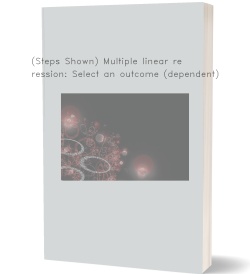Sufficient iron stores Iron deficient without anemia Iron deficient with anemia 8 4 4 7 6 4 10 7 7 6 4
Problem 1
| Sufficient iron stores | Iron deficient without anemia | Iron deficient with anemia |
| 8 | 4 | 4 |
| 7 | 6 | 4 |
| 10 | 7 | 7 |
| 6 | 4 | 2 |
| 9 | 9 | 3 |
We wish to compare language skills in children with sufficient iron stores, iron deficiency without anemia, and iron deficiency with anemia. We obtain a language measure at age 3 years.
Answer the following:
- What type of data is this?
- Nominal b. Ordinal c. Continuous
2. How many groups are being analyzed?
- One b. Two c. More than two
3. If 2 or more groups are they independent or repeated measures?
- Independent b. Repeat measures
Assume that the data is normally distributed:
4 . Please perform the analysis using both the most appropriate parametric test and its nonparametric equivalent. Do this using SPSS (List names of test(s) used - LABEL & HAND IN SPSS output & syntax
5. Interpret the SPSS output in each case :
- List the test statistic for each test (e.g., t, F, r, chi-square, etc.).
- List the p-value for each test.
- Determine if you would accept or reject the null hypothesis for each test.
- For the parametric test:
i. Write the equation for the test statistic.
ii. Use the SPSS output in the above equation to calculate the test statistic by hand.
Show all work.
Problems 4-7: Use the attached database ("database for final v2") to answer the problems 4-7 from a study of whether lead affects development in children. This database includes 3 variables:
Lead level - child's blood lead in mcg/dl
Development score - developmental score (expected mean 100, SD 15)
Maternal education -last completed year of education
Problem 2
We wish to determine the correlation between lead level and developmental status?
Answer the following:
1. What type of data is each variable?
Lead Level a. Nominal b. Ordinal c. Continuous
Developmental Status a. Nominal b. Ordinal c. Continuous
2 . Please perform the analysis using both the most appropriate parametric test and its nonparametric equivalent. Do this using SPSS.
(List names of testes) used - LABEL & HAND IN SPSS output & syntax ).
3. Interpret the SPSS output in each case:
a. List the test statistics (e.g., t, F, r, chi-square, etc.)
b. List the p-value
c. Determine if you would accept or reject the null hypothesis
d. For the parametric test, what is the direction of the relationship, and what is the magnitude of association (effect size)
Problem 3
-
Re-analyze whether there is a relationship between lead level and developmental status using linear regression. Do this in SPSS using the same data set as problem 4
–
(LABEL & HAND IN SPSS output & syntax ) - Make a graph of the data in order to determine whether lead level and development score are linearly associated. Based on the graph, do you think that the data is linearly associated and why.
-
Interpret the SPSS output:
(LABEL & HAND IN SPSS output & syntax)
- What is the independent variable? What is the dependent variable? Why?
- What is the R and R-squared for the regression? How are the two related? What is the amount of variability that is predicted by the regression?
- List the F-statistic and the p-value for the regression.
- Interpret the B and Beta for the predictor variable - both magnitude and significance
- Write out a linear regression equation based on the output.
- What would you predict the development score would be for a child with a lead level of 18? Show how you calculated this.
Problem 4
Use the same data from problem 4 to do the following:
- Make a graph of the data in order to determine whether maternal education and development score are lin early associated. Based on the graph do you think that the data is linearly associated and why.
- Use multiple regression to de termine whether lead level and / or mother's education predict developmental score. Do this in SPSS. (LABEL & H AND IN SPSS output & syntax)
- Interpret the SPSS output : (LABEL & HAND IN SPSS output & syntax)
- What is/are the independent variable(s)? What is/are the dependent variable(s)? Why?
- What is the R and R-squared for the regression? How are the two related? What is the amount of variability that is predicted by the regression?
- List the F-statistic and the p-value for the regression.
- Interpret the B for each predictor variable - both magnitude and significance
- Write out a linear regression equation based on the output .
5. What would you predict the developmental score would be for a child who has a lead level of 18 whose mother completed 7 th g rade? Show how you calculated this.
Problem 5
Use the same data to do the following:
1. Dichotomize lead - as <10, 10 to <15, and 15 or more. What kind of data is this?
a. Nominal b. Ordinal c. Continuous
2. Dichotomize development as low (<85) or normal (85 or more).
a. Nominal b. Ordinal c. Continuous
3. Analyze association between dichotomized lead and dichotomized development using a Chi-Square. Do this using SPSS.
(List names of test(s) used - LABEL & HAND IN SPSS output & syntax).
4. Interpret the SPSS output :
- List the assumptions (if any) for this test and determine whether these assumptions have been met.
- List the test statistic and p-value
- Determine if you would accept or reject the null hypothesis
5. Filter the database so as to only include children with lead level <15.
6. Now compare those with lead level <10 to those with lead level 10 or more usina SPSS. Interpret the SPSS output:
(List names of test(s) used - LABEL & HAND IN SPSS output & syntax).
- List the assumptions (if any) for this test and determine whether these assumptions have been met.
- List the test (and statistic if applicable) and p-value for two valid tests
- Determine if you would accept or reject the null hypothesis
Deliverable: Word Document



![[See Solution] Motivation U.S. sheep in the new year the first [See Solution] Motivation U.S. sheep in the](/images/solutions/MC-solution-library-80991.jpg)
![[Step-by-Step] Assignment 1: Descriptive Statistics Using either [Step-by-Step] Assignment 1: Descriptive Statistics Using either](/images/solutions/MC-solution-library-80992.jpg)
![[Steps Shown] Assignment #2 T-test Analysis of Variance Independent [Steps Shown] Assignment #2 T-test Analysis of](/images/solutions/MC-solution-library-80993.jpg)

